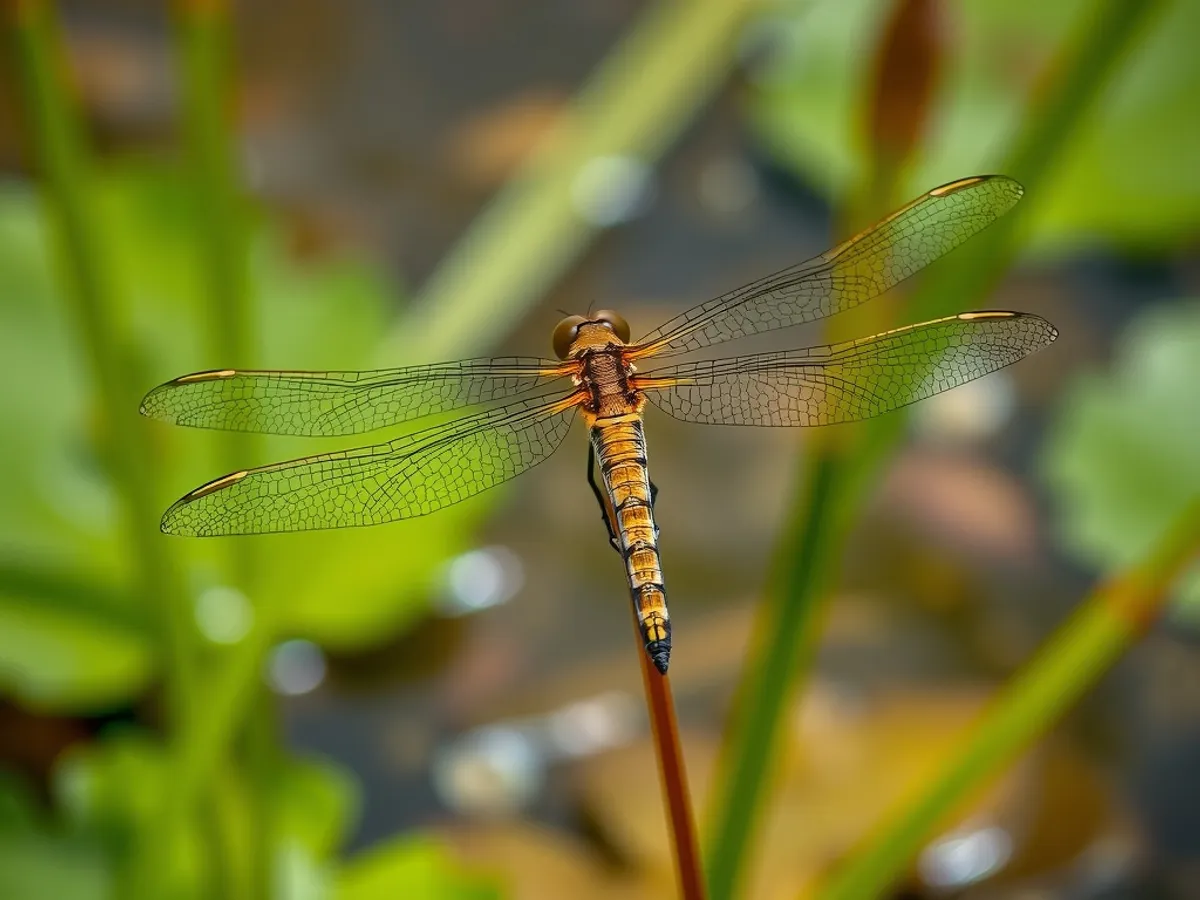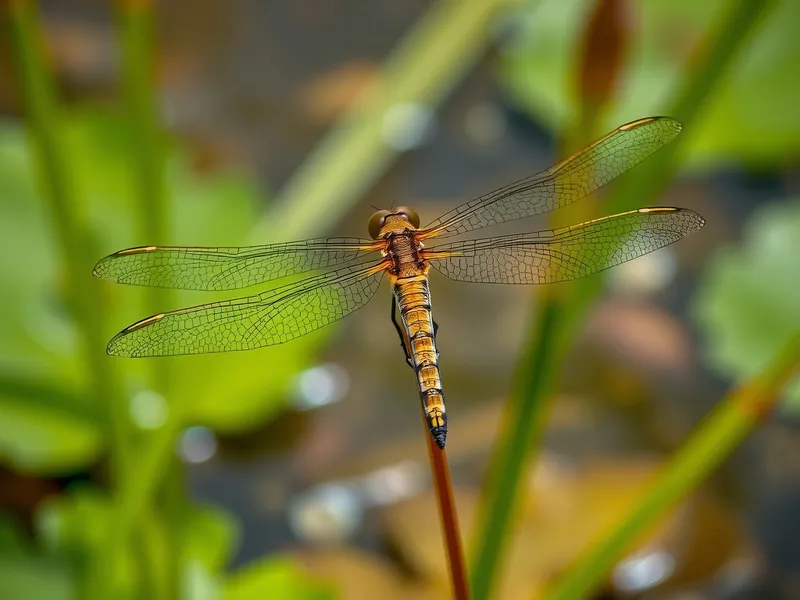
Wandering Glider Dragonfly
Pantala flavescens

Meet the Wandering Glider Dragonfly
The Wandering Glider Dragonfly, also known as the globe skimmer, is one of the most widespread dragonfly species in the world. It is easily recognized by its broad, amber-colored wings and yellowish body, allowing it to glide effortlessly over long distances. This dragonfly is renowned for its extraordinary long-distance migrations, crossing oceans and continents in search of suitable breeding habitats. Its adaptability enables it to thrive in temporary water bodies and a wide variety of climates, from tropical to temperate regions.
Classification
Invertebrate
Habitat
Freshwater ponds, lakes, marshes, temporary rain pools
Diet
Carnivore
Lifespan
4-6 months
Conservation
Least Concern
Weight
0.2–0.3 grams
📖Fascinating Facts
Global Migrant
Pantala flavescens is found on every continent except Antarctica, making it the most widespread dragonfly species in the world.
Epic Journeys
These dragonflies can migrate across entire oceans, with some individuals traveling from India to East Africa by riding seasonal wind currents.
Rapid Reproduction
Their nymphs can complete development in as little as 38 days, allowing them to exploit temporary rain pools before they dry up.
📋Detailed Description
Pantala flavescens, commonly known as the Wandering Glider or Globe Skimmer, is a medium-sized dragonfly with a body length of 40–50 mm and a wingspan of 72–84 mm. Its thorax and abdomen are yellowish to reddish-brown, and its wings are broad, hyaline, and tinged with amber, particularly at the base, which aids in thermoregulation and gliding. The species is renowned for its exceptional flight capabilities, including sustained gliding and hovering, facilitated by its lightweight, aerodynamic body and powerful flight muscles. Unlike many dragonflies, Pantala flavescens is highly migratory, capable of transoceanic journeys exceeding 6,000 km, the longest known migration among insects. Its eyes are large and multifaceted, providing nearly 360-degree vision for detecting prey and predators. The species is adapted to exploit ephemeral water bodies for breeding, with rapid larval development allowing it to complete its life cycle in as little as 38 days. Adults are strong fliers, often seen soaring at high altitudes and covering vast distances in search of suitable habitats. Their ability to tolerate a wide range of temperatures and salinities enables them to inhabit diverse environments, from tropical lowlands to temperate highlands. The Wandering Glider is often solitary but may form loose aggregations during migration or at abundant feeding sites. Its cosmopolitan distribution spans every continent except Antarctica, making it one of the most widespread dragonflies globally.
💡 Did you know?
The Wandering Glider holds the record for the longest known migration of any insect, traveling distances up to 18,000 kilometers.
🔬Research & Sources
🎭Behavior & Social Structure
Wandering Gliders are primarily diurnal, with peak activity during warm daylight hours. They are opportunistic aerial predators, feeding on small flying insects such as mosquitoes, midges, and flies, which they capture in flight using their spiny legs. Their hunting strategy involves both active pursuit and ambush, often patrolling open areas above water or grasslands. While generally solitary, they may aggregate in large numbers during migration or at temporary water bodies for breeding. Males are territorial around prime oviposition sites, engaging in aerial chases to deter rivals. They exhibit remarkable endurance and navigation skills, often using wind currents and weather patterns to facilitate long-distance travel. Resting behavior is typically observed on vegetation near water, where they perch horizontally with wings held outstretched.
👶Reproduction & Life Cycle
Pantala flavescens exhibits a rapid and opportunistic reproductive strategy. Mating occurs in flight, with the male grasping the female behind the head using claspers. The pair forms a 'wheel' position for copulation, which may last several minutes. Females oviposit by dipping the tip of their abdomen into the water surface, often while still in tandem with the male to prevent interference from rivals. Eggs are laid in temporary pools, rain-filled depressions, or shallow ponds, with hatching occurring within a few days. The larval (naiad) stage is highly accelerated, with development from egg to adult possible in as little as 38–60 days, depending on temperature and water availability. There is no parental care; larvae are independent predators, feeding on aquatic invertebrates and mosquito larvae. Breeding can occur year-round in tropical regions, but is often synchronized with seasonal rains in temperate zones.
🛡️Adaptations & Survival
Pantala flavescens possesses several key adaptations for survival and migration. Its broad, flexible wings and lightweight body confer exceptional gliding ability and energy efficiency during long flights. The species can exploit temporary and unpredictable water bodies due to its rapid larval development and tolerance of variable water quality, including brackish and slightly saline conditions. Its large compound eyes provide acute vision for detecting prey and navigating during migration. Behavioral adaptations include the use of prevailing winds and atmospheric currents to facilitate transcontinental travel. Physiologically, it can withstand dehydration and temperature extremes, aiding survival in arid and fluctuating environments. The species' reproductive strategy, with rapid maturation and high fecundity, ensures population persistence despite the ephemeral nature of its breeding sites.
📚Research Sources
🎨Cultural Significance
The Wandering Glider holds symbolic significance in various cultures, often representing change, adaptability, and resilience due to its migratory nature. In some Asian traditions, dragonflies are seen as symbols of good luck, transformation, and the soul. While not commonly used in traditional medicine or material culture, their presence is sometimes noted in folklore and art. Their role as mosquito predators also endears them to communities in malaria-prone regions, where they are considered beneficial insects.
🔬Recent Research & Discoveries
Recent research has focused on the species' extraordinary migratory behavior, with studies using stable isotope analysis and radar tracking to confirm transoceanic flights between India and East Africa. Genetic studies indicate low global genetic differentiation, supporting the idea of continuous gene flow via migration. Ongoing research explores the physiological mechanisms underlying their endurance, navigation, and rapid larval development. Pantala flavescens is also used as a model organism for studying insect migration, climate change impacts, and the colonization of new habitats.
🎥Wildlife Videos

wandering glider
Dragonflies can be seen flying over rice paddies and rivers with the approach of summer. Their bodies measure around 5 ...
Gaiapress Channel

Wandering Glider Dragonfly 1 HQ HD
Profile of a Wandering Glider Dragonfly. Filmed at Morgans Point. October 20, 2021.
PETE DOVE'S NIAGARA WILDLIFE

Wandering glider (Pantala flavescens)
Encounter with the Wandering Glider (Pantala flavescens) in Faridabad's Aravalli Forest. Watch this mesmerizing dragonfly ...
WildSights
![Wandering Glider [Dragonfly]](https://i.ytimg.com/vi/Ug-ix7eL09k/hq720.jpg?sqp=-oaymwEcCOgCEMoBSFXyq4qpAw4IARUAAIhCGAFwAcABBg==&rs=AOn4CLCbOiUKySK4T-ssRmD82zOfI46Avg)
Wandering Glider [Dragonfly]
Medina County Park District

Tiny dragonfly shatters insect migration record, pantala flavescens
Move aside, monarch butterflies. There's a new long-distance insect flyer in town: a tiny dragonfly a mere 4 centimeters in length ...
nidheesh .k.b

Dragonfly HD Documentary
New playlist with hd documentaries! Dragonfly nymphs are ferocious and voracious predators, catching anything that moves with ...
Planet Doc Full Documentaries
🌍Habitat Information
The Wandering Glider Dragonfly typically inhabits Freshwater ponds, lakes, marshes, temporary rain pools environments. Wandering Glider Dragonflys have adapted to their environments with specialized features and behaviors.
Primary Habitat:
Freshwater ponds, lakes, marshes, temporary rain pools
More detailed habitat information will be available soon.
🛡️Conservation Status
The Wandering Glider Dragonfly is currently classified as Least Concern. Conservation efforts are crucial for preserving this species for future generations.
Common Threats:
- 🏠Habitat loss and fragmentation
- 🌡️Climate change impacts
- 🎯Hunting and poaching
- 🏭Human-wildlife conflict
⚠️Threats & Conservation Challenges
Currently classified as Least Concern by the IUCN, Pantala flavescens faces few significant global threats due to its wide distribution, adaptability, and high reproductive rate. However, localized challenges include habitat loss from wetland drainage, pollution, pesticide use, and climate change, which may alter rainfall patterns and the availability of breeding sites. The species' reliance on temporary water bodies makes it vulnerable to prolonged droughts. Despite these pressures, population trends remain stable or increasing in most regions, and its ability to disperse widely mitigates localized declines.
🔬Scientific Classification
Scientific Name
Pantala flavescens
Classification Hierarchy
🔍 About Taxonomic Classification
Taxonomic classification is a hierarchical system used by scientists to classify and organize living organisms based on shared characteristics and evolutionary relationships.
The system moves from broad categories (Kingdom) to increasingly specific ones, with each animal's scientific name typically consisting of its Genus and species.
📝Community Notes
Share your observations and insights about the Wandering Glider Dragonfly with our community of wildlife enthusiasts.
Join Our Community
Sign in to share your observations and connect with fellow wildlife enthusiasts.
Sign In to ContributeNo community notes yet
Be the first to share your observations about the Wandering Glider Dragonfly!
Explore Wandering Glider Dragonfly
Select a tab above to learn more about this amazing animal.
📸Photo Gallery
No photos available for this animal yet.
🌟Discover More Wildlife
Continue your journey of discovery with more fascinating animals from our database
